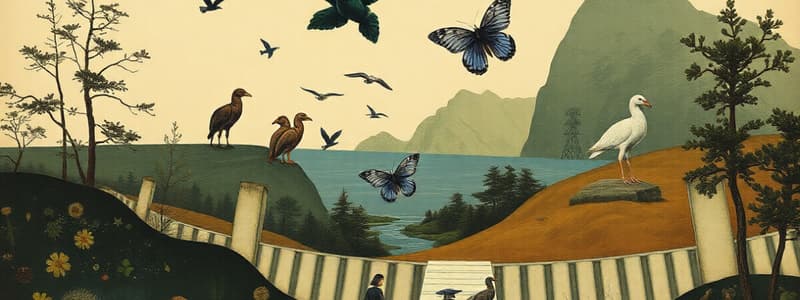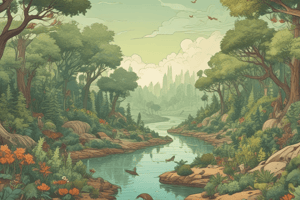Podcast
Questions and Answers
What is the role of decomposers in an ecosystem?
What is the role of decomposers in an ecosystem?
- To absorb nutrients from waste and recycle them (correct)
- To predate on smaller organisms
- To produce energy for herbivores
- To serve as primary producers in food chains
What was a significant environmental impact observed during the decline of the sea otter population in the 1990s?
What was a significant environmental impact observed during the decline of the sea otter population in the 1990s?
- Decrease in marine biodiversity (correct)
- Increase in nutrient levels in the ocean
- Increase in kelp forest size
- Recovery of the sea otter population
What phenomenon explains the increase of toxins at higher levels of the food chain?
What phenomenon explains the increase of toxins at higher levels of the food chain?
- Eutrophication
- Detrification
- Biomagnification (correct)
- Bioaccumulation
What major factor contributed to the decline of the eagle population in the 1900s?
What major factor contributed to the decline of the eagle population in the 1900s?
How many species of plants and animals in Canada are at risk as of January 2024?
How many species of plants and animals in Canada are at risk as of January 2024?
What are the three zones of the biosphere?
What are the three zones of the biosphere?
Which of the following accurately describes a closed system?
Which of the following accurately describes a closed system?
What is meant by 'dynamic equilibrium' in an ecosystem?
What is meant by 'dynamic equilibrium' in an ecosystem?
What are biotic factors in an ecosystem?
What are biotic factors in an ecosystem?
How do terrestrial and aquatic ecosystems support biodiversity?
How do terrestrial and aquatic ecosystems support biodiversity?
Which of the following statements reflects the current state of Earth's equilibrium?
Which of the following statements reflects the current state of Earth's equilibrium?
Which component can be considered an abiotic factor in an ecosystem?
Which component can be considered an abiotic factor in an ecosystem?
What role does the upper atmosphere play in the biosphere?
What role does the upper atmosphere play in the biosphere?
Which statement best reflects a proactive approach to the future?
Which statement best reflects a proactive approach to the future?
What is the main focus of ecology?
What is the main focus of ecology?
Which of the following is considered a biotic factor in ecology?
Which of the following is considered a biotic factor in ecology?
What does the prefix 'abiotic' mean?
What does the prefix 'abiotic' mean?
Which of the following best describes the statement, 'You must be the change you wish to see in the world'?
Which of the following best describes the statement, 'You must be the change you wish to see in the world'?
Which quote emphasizes the responsibility towards future generations?
Which quote emphasizes the responsibility towards future generations?
In an aquatic ecosystem, which of the following would be classified as an abiotic factor?
In an aquatic ecosystem, which of the following would be classified as an abiotic factor?
Which of these phrases best captures the essence of despair in relation to future actions?
Which of these phrases best captures the essence of despair in relation to future actions?
What primary factor is currently driving the high extinction rate of species?
What primary factor is currently driving the high extinction rate of species?
How does acid rain specifically affect frog reproduction?
How does acid rain specifically affect frog reproduction?
Which group of frogs is most affected by increasing ultraviolet radiation?
Which group of frogs is most affected by increasing ultraviolet radiation?
What is the primary role of an umbrella species in conservation efforts?
What is the primary role of an umbrella species in conservation efforts?
What impact does increased fossil fuel use have on frog populations?
What impact does increased fossil fuel use have on frog populations?
What is the primary focus of population ecologists?
What is the primary focus of population ecologists?
Which of the following best describes a food chain?
Which of the following best describes a food chain?
What role do producers play in a food chain?
What role do producers play in a food chain?
How does biodiversity affect an ecosystem's stability?
How does biodiversity affect an ecosystem's stability?
What is typically true about community dynamics?
What is typically true about community dynamics?
What factors might influence the structure of an ecosystem?
What factors might influence the structure of an ecosystem?
Which type of organism is classified as an omnivore?
Which type of organism is classified as an omnivore?
What can result from the extinction of a single species in an ecosystem?
What can result from the extinction of a single species in an ecosystem?
What is the definition of an extirpated species?
What is the definition of an extirpated species?
Which species is classified as endangered?
Which species is classified as endangered?
What major factor is identified as the primary cause of amphibian population declines?
What major factor is identified as the primary cause of amphibian population declines?
What role do indicator species play in an ecosystem?
What role do indicator species play in an ecosystem?
Which of the following is NOT a primary reason for the disappearance of amphibians?
Which of the following is NOT a primary reason for the disappearance of amphibians?
What percentage of North America's frogs and toads are reported to be in trouble?
What percentage of North America's frogs and toads are reported to be in trouble?
What is the suggested extinction rate compared to the natural historical rate?
What is the suggested extinction rate compared to the natural historical rate?
Why are amphibians at greater risk due to their habitat requirements?
Why are amphibians at greater risk due to their habitat requirements?
Flashcards
Biosphere
Biosphere
The narrow zone around Earth that sustains life, encompassing land, water, and air.
Closed System
Closed System
A system where matter cannot be exchanged with the surroundings, but energy can.
Dynamic Equilibrium
Dynamic Equilibrium
A state of balance in an ecosystem where each component adjusts to changes without disrupting the whole system.
Lithosphere
Lithosphere
Signup and view all the flashcards
Hydrosphere
Hydrosphere
Signup and view all the flashcards
Atmosphere
Atmosphere
Signup and view all the flashcards
Interconnections in Nature
Interconnections in Nature
Signup and view all the flashcards
Human Impact on Equilibrium
Human Impact on Equilibrium
Signup and view all the flashcards
What is a population?
What is a population?
Signup and view all the flashcards
What is population ecology?
What is population ecology?
Signup and view all the flashcards
What is a community?
What is a community?
Signup and view all the flashcards
What is community ecology?
What is community ecology?
Signup and view all the flashcards
Define Ecosystem.
Define Ecosystem.
Signup and view all the flashcards
What is ecosystem ecology?
What is ecosystem ecology?
Signup and view all the flashcards
What is a food chain?
What is a food chain?
Signup and view all the flashcards
What are producers?
What are producers?
Signup and view all the flashcards
Despair
Despair
Signup and view all the flashcards
Resignation
Resignation
Signup and view all the flashcards
Ignorance
Ignorance
Signup and view all the flashcards
Ecology
Ecology
Signup and view all the flashcards
Biotic Factors
Biotic Factors
Signup and view all the flashcards
Abiotic Factors
Abiotic Factors
Signup and view all the flashcards
Decomposers
Decomposers
Signup and view all the flashcards
Biomagnification
Biomagnification
Signup and view all the flashcards
Extirpated Species
Extirpated Species
Signup and view all the flashcards
Endangered Species
Endangered Species
Signup and view all the flashcards
Threatened Species
Threatened Species
Signup and view all the flashcards
Indicator Species
Indicator Species
Signup and view all the flashcards
What is Habitat?
What is Habitat?
Signup and view all the flashcards
Extinction
Extinction
Signup and view all the flashcards
Why are Amphibians good indicators?
Why are Amphibians good indicators?
Signup and view all the flashcards
What is the biggest threat to amphibians?
What is the biggest threat to amphibians?
Signup and view all the flashcards
What is an umbrella species?
What is an umbrella species?
Signup and view all the flashcards
What is the impact of ultraviolet radiation on frogs?
What is the impact of ultraviolet radiation on frogs?
Signup and view all the flashcards
How does acid rain affect frog reproduction?
How does acid rain affect frog reproduction?
Signup and view all the flashcards
How does climate change contribute to the decline of frog populations?
How does climate change contribute to the decline of frog populations?
Signup and view all the flashcards
Why are frogs considered bioindicators of environmental health?
Why are frogs considered bioindicators of environmental health?
Signup and view all the flashcards
Study Notes
The Biosphere as a Closed System
- Earth is a closed system, meaning matter is not exchanged with its surroundings, but energy is exchanged.
- All living things interact with each other and non-living things on Earth.
- The biosphere is a narrow zone around Earth with life.
- It has three zones: lithosphere (land), hydrosphere (water), and atmosphere (air).
- The upper atmosphere and Earth's crust affect living organisms, even though they aren't part of the biosphere.
- There are interconnectedness and complexities in nature.
Outcomes
- Explain the structure of ecosystem trophic levels (using food chains and food webs).
- Define species, population, community, and ecosystem.
- Explain interrelationships among these entities.
- Explain how terrestrial and aquatic ecosystems support diversity through habitats and niches.
- Identify biotic and abiotic characteristics and explain their influence in ecosystems (local region).
The Biosphere
- The biosphere is the narrow zone around Earth with life.
- Within the biosphere are three key zones: land (lithosphere), water (hydrosphere), and air (atmosphere).
- Even though the upper atmosphere and Earth's crust are outside the biosphere, they still influence living organisms.
Nature is Full of Interconnections and Complexities/Ecosystem Dynamics
- Earth is a complex system where all components are interconnected
- A closed system does not exchange matter with surroundings, but does exchange energy with its surroundings
- Living things are connected to each other and to nonliving components, like air, water, soil, and sunlight.
Ecosystem Dynamics (Simplified Scheme)
- Energy flows from the sun.
- Organisms use energy and cycle matter.
- Materials ultimately return to the environment and cycle back to producers (Plants and Algae)
Dynamic Equilibrium
- Every part of Earth's environment must be in balance with everything else
- Dynamic equilibrium occurs when components of a system adjust to constant changes without disturbing the entire system
- If something within an ecosystem changes, something else can adjust to avoid unbalancing the entire system
- Today, Earth's equilibrium is being affected by human activities
Biodiversity
- Biodiversity is the number of species within an ecosystem.
- The more biodiversity within an ecosystem, the more resistant or immune it is to collapse.
- Extinction of species can create a domino effect that can collapse the entire food chain within an ecosystem because they are connected.
Food Chains
- A food chain is a sequence of organisms that feed on each other through the ecosystem.
- Producers are the organisms that create their own food using the sun's energy and nutrients in the soil/water. (Plants and algae)
- Consumers are organisms that rely on producers (Herbivores) or other living organisms (Carnivores) for food.
- Decomposers, like fungi and bacteria, break down waste and dead organisms, recycling the nutrients back into the ecosystem.
Interconnectedness
- Studying interconnectedness is crucial to understanding ecosystems.
- For example, the effects of hunting otters almost to extinction and their uneven recovery demonstrated the interconnectedness of different species and their impact on the ocean ecosystem (e.g. kelp forests)
Biomagnification
- Biomagnification is a process where substances increase in concentration at higher levels within a food web.
- Toxins enter food webs via producers, and the concentration of these toxins increases as they move through the higher levels of the food web, meaning that top-level consumers are particularly affected.
Species at Risk
- More than 450 species of plants and animals are at various degrees of risk in Canada.
- Species at risk can be categorized as Extinct, Endangered, Threatened, or Special Concern.
-These categories encompass the level of risk associated with each species.
- Specific examples (e.g., Black-footed ferret, Woodland Caribou) of species at risk are provided.
Indicator Species
- Indicator species are very sensitive to small environmental changes
- They provide an early warning system about ecosystem balance
- Amphibians, for example, are indicator species, as their eggs and tadpoles live in water, and their adult forms in the forest, making them susceptible to hazards in both
Why are Amphibians Disappearing?
- Amphibians have been around for over 400 million years.
- Losses in their population are due to environmental disturbances like habitat loss, changing air and water quality, climate change, and ultraviolet radiation.
Loss of Habitat
- Frogs, specifically, require wetlands, ponds, and lakes with clean water to breed and lay eggs, and adults need a place to catch insects in fields or forests.
- They also need safe passage between these areas.
- Human activities impacting wetlands, ponds, and lakes cause losses of these habitats.
Extinction Rates
- Current extinction rates are significantly higher than natural, historical rates
- The current extinction crisis is mainly caused by humans' activities and global warming from increased CO2
Air and Water Quality
- Air and water pollutants, such as acid rain, affect frog reproduction
Air Pollution
- Air pollution, quantified by PM2.5 levels, varies across different cities.
- Higher PM2.5 levels indicate more severe air pollution.
Climate Change
- Increasing temperatures and fossil fuel usage are linked,
- Changing climate conditions result in drying climates, impacting frog populations.
Umbrella Species
- A conservation strategy for making conservation decisions that protect many other species indirectly.
Additional Information
-
The image of a frog in a pot of water on fire implies the importance of acting to preserve biodiversity, highlighting that seemingly slow changes in environmental conditions may affect species.
-
The image of a crossroads suggests the need to choose a better path for a better future, implying the impact humans have on the planet and decision-making for a sustainable future.
-
The image of buildings with green roofs, solar panels, and wind turbines showcases examples of environmentally friendly solutions.
Studying That Suits You
Use AI to generate personalized quizzes and flashcards to suit your learning preferences.




